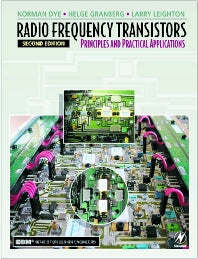Freshly Printed - allow 10 days lead
Couldn't load pickup availability
Radio Frequency Transistors
Principles and Practical Applications
Norman Dye (Author), Helge Granberg (Author)
9780750672818, Elsevier Science
Paperback, published 8 March 2001
320 pages
18.9 x 24.6 x 2.1 cm, 0.64 kg
"...a complete tool kit for RF circuit design." --RF Globalnet
Radio Frequency Transistors: Principles and Practical Applications is a complete tool kit for successful RF circuit design. As cellular and satellite communications fields continue to expand, the need for RF circuit design grows. Radio Frequency Transistors contains a wealth of practical design information based on years of experience from authors who have worked with the leading manufacturers of RF components. The book focuses primarily on the more difficult area of high power transistor amplifier design and construction. An entire chapter devoted solely to LDMOS high power RF transistors has been added to the new edition. A comparison is given between LDMOS FETs, TMOS FETs and bipolar transistors, showing clearly why LDMOS is the designer's choice for high power, linear amplifiers in today's rapidly expanding digital world of communications. Coverage also includes applications of LDMOS RF high power transistors in current generation cellular technologies, the design of LDMOS high power amplifiers, and comments about the latest efforts to model LDMOS RF power devices. Other topics covered include the selection of matched high power RF transistors, input impedance matching of high power transistors, interstage matching, and capacitors and inductors at radio frequencies.
Understanding RF data sheet parameters
DC specifications
Functional characteristics for power transistors, low power transistors, linear modules, and power modules
RF transistor fundamentals
Transistor characteristics in specific applications
Bandwidth considerations
MOSFETs vs. bipolars
FETs and BJTs
types of transistors
Comparing parameters
Circuit configurations
Common emitter and common source
Common Base and common gate
Common collector and common drain
Classes of operation
Forms of modulation
Operating transistors in pulse mode
Reliability considerations
Construction techniques
Types of packages
Emitter/source inductance
Laying out a circuit board
Tips for systematic PC layout design
Mounting RF devices
RF modules
Power amplifier design
Single-ended RF amplifier designs
Parallel transistor amplifiers
MOSFETs
Push-pull amplifiers
Computer-aided design programs
Circuit testing
Types of low-pass filters
Wideband impedance matching
Conventional transformers
Twisted wire transformers
Transmission line transformers
Equal delay transmission line transformers
Power splitting and combining
Basic types of power combiners
In phase and 180 degree combiners
90 degree hybrids
Line hybrids
Ring hybrids
Branch line couplers
Wilkinson couplers
Frequency compensation and negative feedback
LDMOS high power transistors
Differences between LDMOS high power transistors and bipolars
Differences between LDMOS high power transistors and TMOS FETs
Designing high power RF amplifiers using LDMOS
Small signal amplifier design
Scattering parameters
Noise parameters
Biasing considerations
Power gain
Stability
Actual steps in low power amplifier design
and much more
Subject Areas: Radio technology [TJKR], Electronic devices & materials [TJFD], Circuits & components [TJFC]


